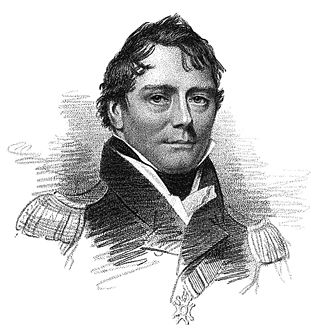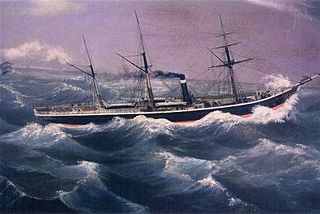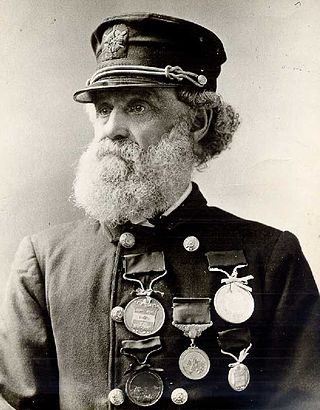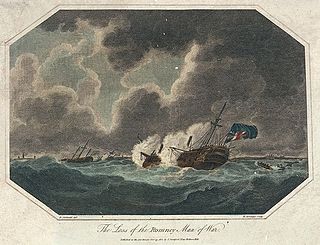Related Research Articles
Ann Harvey (1811–1860) was a fisher and rescuer born near the small fishing community of Isle aux Morts, Newfoundland. Harvey, called the "Grace Darling of Newfoundland", is known for her bravery at the age of seventeen for rescuing, along with her father, younger brother and their Newfoundland dog, 163 shipwrecked people from the brig Despatch between July 12–15, 1828. Despatch had departed from Derry in late May, carrying nearly 200 Irish immigrants bound for Quebec City, but on July 10, a fierce storm wrecked the brig on the rocks near Isle aux Morts.
The Norwegian Lady Statues are located in the sister cities of Moss, a coastal town and municipality in the county of Østfold, Norway, and at the Oceanfront (boardwalk) in the coastal resort city of Virginia Beach, Virginia in the United States. They commemorate the lives lost in the 1891 shipwreck of the Norwegian barque Dictator off the coast of Virginia Beach and the lifesaving efforts of the community.

MV Dunedin Star was a British refrigerated cargo liner. It was built by Cammell Laird and Co in 1935–36 as one of Blue Star Line's Imperial Star-class ships, designed to ship frozen meat from Australia and New Zealand to the UK. It served in the Second World War and is distinguished for its role in Operation Halberd to relieve the siege of Malta in September 1941.

A castaway is a person who is cast adrift or ashore. While the situation usually happens after a shipwreck, some people voluntarily stay behind on a deserted island, either to evade captors or the world in general. A person may also be left ashore as punishment (marooned).
Aeneas was a wooden sailing ship named after the Trojan hero of the Iliad.

Captain Sir Murray Maxwell, CB, FRS was a British Royal Navy officer who served with distinction in the late eighteenth and early nineteenth centuries, particularly during the French Revolutionary and Napoleonic Wars. Maxwell first gained recognition as one of the British captains involved in the successful Adriatic campaign of 1807–1814, during which he was responsible for the destruction of a French armaments convoy at the action of 29 November 1811. As a result of further success in the Mediterranean, Maxwell was given increasingly important commissions and, despite the loss of his ship HMS Daedalus off Ceylon in 1813, was appointed to escort the British Ambassador to China in 1816.

SS Admella was an Australian passenger steamship that was shipwrecked on a submerged reef off the coast of Carpenter Rocks, south west of Mount Gambier South Australia, in the early hours of 6 August 1859. Survivors clung to the wreck for over a week and many people took days to die as they glimpsed the land from the sea and watched as one rescue attempt after another failed.

Joshua James was an American sea captain and a U.S. Life–Saving Station keeper. He was a famous and celebrated commander of civilian life-saving crews in the 19th century, credited with saving over 500 lives from the age of about 15 when he first associated himself with the Massachusetts Humane Society until his death at the age of 75 while on duty with the United States Life–Saving Service. During his lifetime he was honored with the highest medals of the Humane Society and the United States. His father, mother, brothers, wife, and son were also lifesavers in their own right.

Rear-Admiral Robert Carthew Reynolds was a long serving and widely respected officer of the British Royal Navy who served in four separate major wars in a 52-year career. During this time he saw only one major battle, although was engaged in one of the most noted frigate actions of the French Revolutionary Wars, the destruction of the Droits de l'Homme, in which his own frigate was driven ashore and wrecked. Reynolds died in 1811 during a great storm in late December, which scattered his convoy and wrecked three ships of the line including his own flagship HMS St George. Over 2,000 British sailors, including Reynolds, were drowned.
Blackpool and the Fylde coast has become a ship graveyard to a number of vessels over the years. Most of the shipwrecks occurred at or near Blackpool, whilst a few happened a little further afield but have strong connections with the Blackpool area. For the purposes of this article, Blackpool means the stretch of coast from Fleetwood to Lytham St Annes.

The action of 13 January 1797 was a minor naval battle fought between a French ship of the line and two British frigates off the coast of Brittany during the French Revolutionary Wars. During the action the frigates outmanoeuvred the much larger French vessel and drove it onto shore in heavy seas, resulting in the deaths of between 400 and 1,000 of the 1,300 persons aboard. One of the British frigates was also lost in the engagement with six sailors drowned after running onto a sandbank while failing to escape a lee shore.

A castaway depot is a store or hut placed on an isolated island to provide emergency supplies and relief for castaways and victims of shipwrecks.

HMS Romney was a 50-gun fourth rate of the Royal Navy. She served during the American War of Independence, and the French Revolutionary and Napoleonic Wars in a career that spanned forty years. Five ships of the Royal Navy have been named HMS Romney. The origins of the name are from the town of New Romney, although it may be that the name entered the Royal Navy in honour of Henry Sydney, 1st Earl of Romney.

SS Myron was a wooden steamship built in 1888. She spent her 31-year career as lumber hooker, towing schooner barges on the Great Lakes. She sank in 1919, in a Lake Superior November gale. All of her 17 crew members were killed but her captain survived. He was found drifting on wreckage near Ile Parisienne. Her tow, the Miztec, survived. Myron defied the adage that Lake Superior "seldom gives up her dead" when all 17 crewmembers were found frozen to death wearing their life jackets. Local residents chopped eight of Myron's sailors from the ice on the shore of Whitefish Bay and buried them at the Mission Hill Cemetery in Bay Mills Township, Michigan.

HMS Magnet was a Cruizer-class brig-sloop built at Robert Guillaume’s yard at Northam and launched in 1807. She served in the Baltic, where she took two prizes, one an armed privateer, before wrecking in 1809.
Many ships have wrecked in and around San Francisco Bay. For centuries San Francisco Bay, with its strong currents, rocky reefs, and low fog conditions has experienced more than a hundred shipwrecks. Ever since San Francisco Bay was discovered during the land expedition of Gaspar de Portolà in 1769, it has been one of the most popular harbors.
The SS G. P. Griffith was a passenger steamer that burned and sank on Lake Erie on 17 June 1850, resulting in the loss of between 241 and 289 lives. The destruction of the G. P. Griffith was the greatest loss of life on the Great Lakes up to that point, and remains the third-greatest today, after the SS Eastland in 1915 and the Lady Elgin in 1860.
References
- S.W. Fullom, The Life and Correspondence of General Sir Howard Douglas
- R.S. Lambert, Redcoat Sailor: The Adventures of Sir Howard Douglas